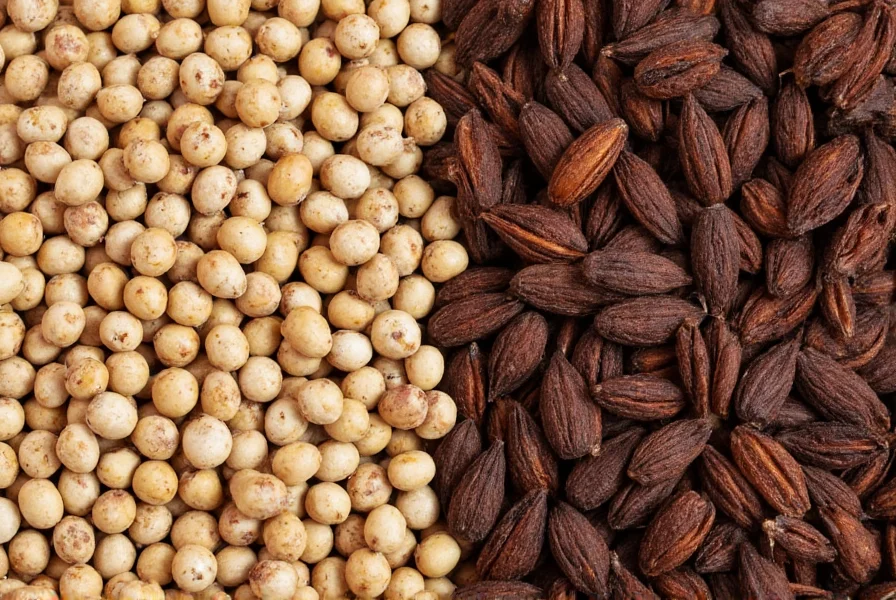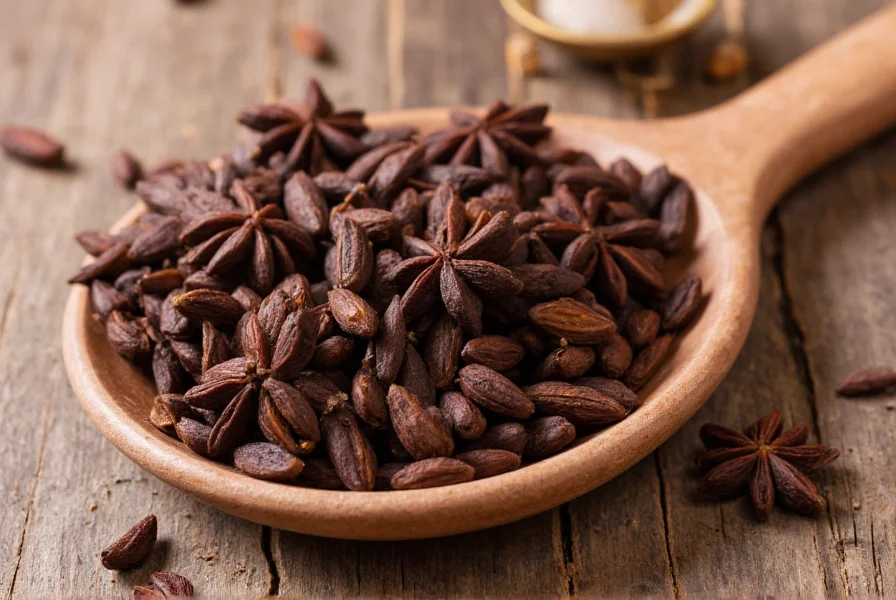Anise and licorice are distinct plants with similar flavor profiles but different botanical origins, chemical compositions, and culinary applications. Anise (Pimpinella anisum) is an annual herb in the parsley family that produces small seeds containing anethole, while licorice (Glycyrrhiza glabra) is a perennial legume whose root contains glycyrrhizin. Despite their comparable sweet, aromatic flavors, they cannot be used interchangeably in all recipes due to differences in intensity and chemical properties.
Many home cooks and food enthusiasts confuse anise and licorice because both deliver that distinctive sweet, aromatic flavor profile commonly associated with black jelly beans or certain herbal teas. This confusion stems from their shared dominant flavor compound—anethole—which creates that characteristic "licorice-like" taste. However, understanding the botanical and chemical distinctions between these two ingredients is essential for proper culinary application and informed consumption.
Botanical Origins: Two Different Plants
Anise, scientifically known as Pimpinella anisum, belongs to the Apiaceae family, which includes carrots, celery, and parsley. This annual herb produces small, grayish-brown seeds that contain 2-7% essential oil, primarily composed of anethole (80-90%). Anise plants thrive in Mediterranean climates and have been cultivated for over 4,000 years for both culinary and medicinal purposes.
Licorice, or Glycyrrhiza glabra, comes from the root of a perennial plant in the Fabaceae (legume) family. Unlike anise seeds, licorice root contains glycyrrhizin, a compound 30-50 times sweeter than sugar. This plant grows wild in parts of Europe and Asia and has been used in traditional Chinese and Ayurvedic medicine for centuries. The key difference in their chemical makeup explains why licorice delivers a longer-lasting sweetness compared to anise's more immediate but shorter-lived flavor.
| Characteristic | Anise | Licorice |
|---|---|---|
| Botanical Family | Apiaceae (carrot family) | Fabaceae (legume family) |
| Primary Flavor Compound | Anethole (80-90% of essential oil) | Glycyrrhizin (plus some anethole) |
| Natural Sweetness Level | Mildly sweet | 30-50 times sweeter than sugar |
| Plant Part Used | Seeds | Root |
| Flavor Duration | Shorter, more immediate | Longer-lasting sweetness |
Culinary Applications and Substitution Guidelines
Chefs and home cooks often wonder whether anise and licorice can be substituted for one another. The answer depends on the specific recipe and desired outcome. In Mediterranean cuisine, anise seeds frequently flavor breads, cookies, and fish dishes, while Middle Eastern and Asian cuisines incorporate both ingredients but in different applications.
When substituting anise for licorice in recipes, use approximately three times the amount of anise to match licorice's sweetness intensity. However, this substitution works best in baked goods rather than beverages, as licorice root's complex flavor profile includes earthy notes that anise alone cannot replicate. For authentic absinthe or ouzo production, anise remains the primary flavoring agent, though some traditional recipes incorporate small amounts of licorice root for complexity.

Health Considerations and Medicinal Properties
Both anise and licorice have documented health benefits but also important safety considerations. Anise has been traditionally used to alleviate digestive issues and respiratory conditions, with modern research supporting its antispasmodic and antimicrobial properties. Licorice root contains compounds with anti-inflammatory effects and has been studied for potential benefits in treating ulcers and sore throats.
However, excessive licorice consumption (more than 30g of licorice root daily for extended periods) can cause hypertension and electrolyte imbalances due to glycyrrhizin's effect on cortisol metabolism. People with heart conditions, kidney disease, or high blood pressure should exercise caution with licorice products. Anise generally presents fewer health concerns but may interact with certain medications due to its estrogen-like compounds.
Identifying Authentic Products
When shopping for anise or licorice products, understanding labeling practices prevents disappointment. True licorice candy contains actual licorice root extract, while many "licorice-flavored" products in the United States use anise oil instead due to licorice's stronger flavor and potential health concerns. European regulations require products labeled as "licorice" to contain genuine licorice root extract.
For culinary applications, whole anise seeds maintain their flavor longer than ground versions. Licorice root is available dried, as a powder, or in extract form. When purchasing licorice supplements, look for products standardized to glycyrrhizin content and consider deglycyrrhizinated licorice (DGL) if you have blood pressure concerns but want the digestive benefits.

Traditional and Modern Uses
Cultures worldwide have incorporated these flavorings into traditional practices. In Egypt, anise has been found in pharaonic tombs, indicating its historical value. Traditional Chinese medicine uses licorice root as a harmonizing agent in herbal formulas. Modern applications extend beyond food—both ingredients appear in natural cough syrups, toothpaste, and even some tobacco products.
Understanding the difference between anise licorice flavor profiles helps consumers make informed choices whether they're following a traditional recipe, selecting herbal remedies, or simply satisfying a craving for that distinctive sweet-aromatic taste. While their flavors share similarities, recognizing their botanical distinctions enhances both culinary success and informed consumption.
What's the main difference between anise and licorice?
The primary difference lies in their botanical origins and chemical composition. Anise comes from the seeds of Pimpinella anisum (an herb in the parsley family) and gets its flavor primarily from anethole. Licorice comes from the root of Glycyrrhiza glabra (a legume plant) and contains glycyrrhizin, which is 30-50 times sweeter than sugar. While both contain anethole, licorice has a more complex, longer-lasting sweetness due to glycyrrhizin.
Can I substitute anise for licorice in recipes?
You can substitute anise for licorice in some recipes, but not all. Use approximately three times the amount of anise to match licorice's sweetness intensity. This substitution works best in baked goods but is less effective in beverages, as licorice root has earthy notes that anise cannot replicate. For authentic licorice-flavored products like certain liqueurs, the substitution may significantly alter the final flavor profile.
Why does licorice affect blood pressure but anise doesn't?
Licorice contains glycyrrhizin, which inhibits an enzyme that regulates cortisol metabolism, potentially causing sodium retention and potassium loss that can elevate blood pressure. Anise contains minimal glycyrrhizin and primarily features anethole, which doesn't affect this metabolic pathway. People with hypertension should limit licorice consumption but can generally consume anise without this concern.
How can I tell if a "licorice" product actually contains real licorice?
Check the ingredient list: authentic licorice products will list Glycyrrhiza glabra extract or licorice root. Many American "licorice" candies actually use anise oil instead. European products labeled as licorice typically contain real licorice root. True licorice has a more complex, earthy sweetness compared to the sharper, more immediate flavor of anise-based products.
Are anise and star anise the same as licorice?
No, though they share flavor similarities. Star anise (Illicium verum) is a different plant altogether that also contains anethole, giving it a similar flavor profile to both anise and licorice. While all three share the characteristic sweet-aromatic flavor due to anethole, they come from completely different plant families with distinct chemical profiles and culinary applications.











 浙公网安备
33010002000092号
浙公网安备
33010002000092号 浙B2-20120091-4
浙B2-20120091-4